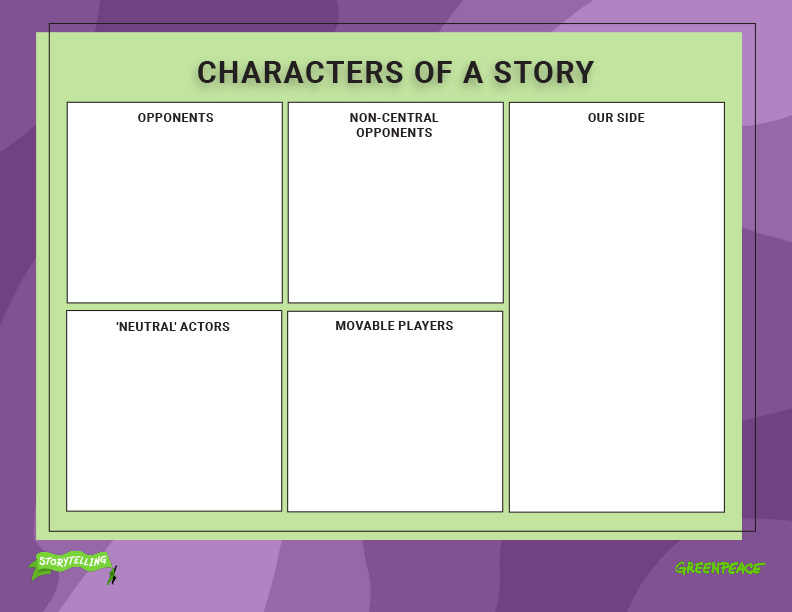STEP FOUR: CHARACTERS
Who is your story about? It’s time to determine your cast of “characters.” A character is a figure who allows us to experience the events of a story. Each character carries with them perspectives that can influence a story towards one direction or another.
CHARACTERS
“Every story, even the driest, has a human face. Draw it well and put it on display, for to readers it is a mirror and a magnet.”
– Francis Flaherty, The New York Times

The story you’re telling is about somebody, it might even be about you. Either way your campaign is about the lives of real people. If you succeed, those lives may improve. As a storyteller, you must keep these people—your characters—front and centre. Audiences are hardwired to be captivated by human drama, and you can maximise your impact by casting your characters wisely.
First and foremost is your protagonist. The protagonist is the person or a collective whose fate is centred in your story. They need not be especially “heroic.” In fact, everyday protagonists may be easier for audiences to relate to than someone whose capabilities seem superhuman or whose list of accomplishments boggles the mind. What’s most important is that their personal problem has a clear link to what your campaign is trying to achieve, and that they can put a sympathetic human face to the issue you’re working on.
Perhaps a factory is dumping toxic chemicals upstream from their community, or maybe they’d like to convert a vacant lot to an urban garden that provides fresh produce for their family. Find the faces that will capture the human story at the core of the issue. In rendering your story, portray your protagonist with dignity even as they experience struggles. Create empathy for your protagonist, and your audience will understand why your campaign is important.
Next, identify your antagonist. The antagonist is the character who is preventing your protagonist from getting what they want. This might be a corporation dumping the chemicals, or a developer bent on turning that vacant lot into luxury condos.
RELATED CASE STUDY
Story work is essential for us to transform the most powerful (and therefore invisible) narratives of a society. To see how we can use storytelling to subvert oppressive narratives about ourselves, check out this case study.
RELATED CASE STUDY
To learn how civil rights activists in the United States skillfully employed storytelling to shape centuries-old dominant narratives and to help advance Black liberation.
USE COUNTER CHARACTERS

In your story, are there characters that are traditionally or stereotypically cast in certain roles? Using a counter character strategy, you can flip the tables. Take a princess in a fairy tale (Paper Bag Princess) and make her the one who rescues the prince. Or take a scary ogre and make him the lovable hero. Even in everyday life, challenging expectations in this manner can be a powerful and surprising way to show the humanity, agency and power of “the powerless.”
TELL PERSONAL STORIES

Expressed as a counter to dominant narratives (which are often impersonal), stories of personal experience can smash myths. Because these stories’ credibility comes from the simple act of speaking one’s truth, this is a tool deployed by many activists. By speaking your personal story, you can also start a chain effect, giving other people the permission and the language to tell their own stories. Personal stories build solidarity and community by letting people know that they’re not alone. Think of the #MeToo movement as a powerful recent example of this strategy.
CHANGE THE NARRATOR

One of the most powerful things we can do to disrupt the existing narrative is to simply change the storytelling perspective. By telling the story from another view, often the person or group that has been silenced or ignored, we can completely upend the dominant narrative.
A celebrated example of post colonial literature, Wide Sargasso Sea by Jean Rhys does this very thing. The novel tells the story of Mr. Rochester from Jane Eyre from the perspective of the “mad” wife of Mr. Rochester. In response to the romantic novel set in the English countryside by Charlotte Bronte, Wide Sargasso Sea tells the story of oppression experienced by a Creole woman who is trapped by patriarchy in England and in Jamaica.
CHANGE THE CENTRAL CHARACTERS

The way a storyteller chooses their characters tells us a lot about what is important to the storyteller. If the story of climate change is about political leaders or scientists, these are seen as the people who matter most in the story. If the story is about a teenager in an island nation threatened by rising sea levels, this tells us something else.
As you think about the story you want to tell, consider whose story it is. This is who matters most in the story. Have the current storytellers got it wrong? Change the characters!
FIND THE RIGHT MESSENGER FOR YOUR STORY

Who is better at telling this story than you? You might be limited in who you can reach directly. In these cases, a messenger is necessary. Find messengers that are already speaking to your target audience. Bring them into the issue, collaborate with them as equals, and you’ll go much further.


